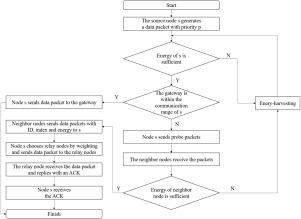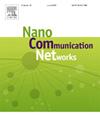DPOR: A data priority-based opportunity routing protocol for intra-body nanonetworks
IF 4.7
4区 计算机科学
Q2 ENGINEERING, ELECTRICAL & ELECTRONIC
引用次数: 0
Abstract
The improvement of nanocommunication technology has promoted intra-body medical applications. With the advancement of nano-devices and terahertz communication technology, the performance of intra-body nanonetworks has been continuously enhanced, making the remote medical data transmission a reality. Intra-body nanonetworks can stably transmit the physiological information captured within the human body to the distant medical service center. Considering the aqueous environment of the human body, the communication of nanonetworks is subject to environmental interference and the physical limitations of nano-devices, and traditional routing protocols are difficult to meet the communication requirements in intra-body nanonetworks. Especially in the aspect of health monitoring,different types of data have corresponding importance, and some urgent data deserve more attention. For example, signals of acute arrhythmias (such as ventricular fibrillation) detected by nano-nodes are of the highest priority. Therefore, this paper designs a Data Priority-based Opportunistic Routing (DPOR) protocol. In this protocol, nano-nodes select the appropriate relay according to the level of data priority to improve the transmission efficiency of intra-body nanonetworks. On this basis, a thermal-aware model is constructed. By restricting the energy of nano-nodes and managing the energy consumption of nodes, it prevents nodes from overheating and damaging human tissues. Simulation experiments show that this model can optimize the routing selection, extend the network lifetime, and ensure the timeliness and reliability of transmission during the data transmission process while ensuring the safety of node temperature.

DPOR:基于数据优先级的体内纳米网络机会路由协议
纳米通信技术的进步促进了体内医疗的应用。随着纳米器件和太赫兹通信技术的进步,体内纳米网络的性能不断增强,使远程医疗数据传输成为现实。体内纳米网络可以稳定地将人体内捕获的生理信息传输到远程医疗服务中心。考虑到人体的水环境,纳米网络的通信受到环境干扰和纳米器件的物理限制,传统的路由协议难以满足体内纳米网络的通信需求。特别是在健康监测方面,不同类型的数据有相应的重要性,一些紧急的数据更值得关注。例如,纳米节点检测到的急性心律失常(如心室颤动)信号是最优先考虑的。为此,本文设计了一种基于数据优先级的机会路由协议(DPOR)。在该协议中,纳米节点根据数据优先级的高低选择合适的中继,以提高体内纳米网络的传输效率。在此基础上,建立了热感知模型。通过限制纳米节点的能量和管理节点的能量消耗,它可以防止节点过热和损害人体组织。仿真实验表明,该模型可以优化路由选择,延长网络寿命,在数据传输过程中保证传输的及时性和可靠性,同时保证节点温度的安全性。
本文章由计算机程序翻译,如有差异,请以英文原文为准。
求助全文
约1分钟内获得全文
求助全文
来源期刊

Nano Communication Networks
Mathematics-Applied Mathematics
CiteScore
6.00
自引率
6.90%
发文量
14
期刊介绍:
The Nano Communication Networks Journal is an international, archival and multi-disciplinary journal providing a publication vehicle for complete coverage of all topics of interest to those involved in all aspects of nanoscale communication and networking. Theoretical research contributions presenting new techniques, concepts or analyses; applied contributions reporting on experiences and experiments; and tutorial and survey manuscripts are published.
Nano Communication Networks is a part of the COMNET (Computer Networks) family of journals within Elsevier. The family of journals covers all aspects of networking except nanonetworking, which is the scope of this journal.
 求助内容:
求助内容: 应助结果提醒方式:
应助结果提醒方式:


